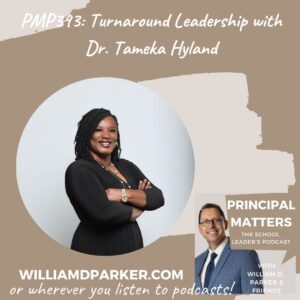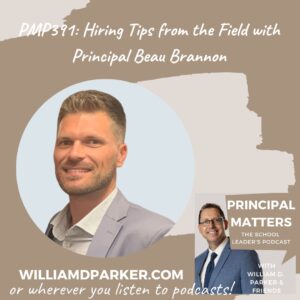Podcast: Play in new window | Download
The other morning, I woke up early in a hotel room in Atlanta, Georgia.

For a moment, I couldn’t remember where I was. Then it dawned on me that I was presenting that morning at a Growing Leaders Principal Roundtable event hosted by Dr. Tim Elmore. I dressed, grabbed my laptop bag and headed downstairs for a hot bowl of oatmeal and a cup coffee before walking the short-distance to the conference event center.
As I sat my bag down near a table up front, I was excited. Not only do I enjoy presenting to other school leaders but also, I was going to hear from some dynamic speakers and presenters as well as interact with principals during discussion times about their best practices.
My own kids tell me I geek-out about principal leadership, and this event was giving me permission to do just that. After playing some fun, interactive introduction games, the lessons began.
I could share for hours about lessons from all the presenters, but for Principal Matters readers and listeners, I want to focus on takeaways from three authors who spoke directly about trends and research that are important to any education leader.
So, I’m going to break this into three parts:
Part 1: Trends Among Gen-Z Students
Part 2: Students Require New Leadership
Part 3: The Power of Timing, Breaks, and Synchronization
Takeaways Part 1: Trends Among Gen-Z Students

With his wavy brown hair and dark rimmed glasses, Andrew looks like someone who could host his own nightly talk show. But don’t let his easy-going personality fool you. He is curious and spends a lot of time surveying and interviewing youth across the county.
In his highly informative session, Andrew McPeak, co-author with Tim Elmore, of the book, Marching Off the Map: Inspire Students to Navigate a Brand New World, highlighted three trends he has seen in his research among students:
1. Students wrestle with expectations fueled by technology.
According to his findings, 96% of high school students now own smartphones, and 41% say social media makes them feel sad, anxious or depressed. Our students face the constant tension of being connected for information while being assaulted with expectations that may be unattainable.
They see people online who display lives of happiness, success or wealth that seem unrealistic but make them feel anxious that they are unable to have the same experiences. Many students recognize the paradox but find it difficult to break free from the very influences that also frustrate and depress them.
2. Students think more about identity, diversity, and equality.
Whereas the generation before them found environmental issues a predominant area of social or global awareness, today’s youth are concerned about identity. They are very aware of the divides and conflicts involved in discussions around race, gender, and sexual orientation. When surveyed, youth consider these the most pressing problems facing the world today.
3. Students are cautious about their futures.
Andrew shared data showing reports that as many as 25% of today’s youth grow up in poverty. And 46% of youth say their biggest personal concern is college debt. They have room to complain. Over the past 35 years, the cost of a college education has increased 1, 120%.
Students are also cautious about their safety. In the 15-year span of 1995-2010, sixty-one school shootings took place in U.S. schools, with 7 resulting in at least 5 deaths. In the past eight years, 2010-2018, 70 school shootings have taken place with 8 of them resulting in 5 or more deaths.
72% of students also admit they are distracted by social media and 58% said they are seeking relief from social media –although they are not always sure how. This narrative causes many youths to look with caution at their futures.
Andrew concluded by encouraging principals to choose a positive narrative. We can either respond with fear that Gen-Z students are in trouble or we can respond with belief that these students are part of the answer we need for our future.
He suggested three great actions:
A. Talk about current issues with students.
B. Give them experiences that include a little risk.
C. Acknowledge their hurts and temptations to give up but offer them hope.
Takeaways Part 2: Students Require New Leadership

In a follow-up presentation, Dr. Tim Elmore, shared additional lessons from Marching off the Map about this emerging generation of students. If you’ve heard Dr. Elmore, you know he is the kind of leader who communicates like your dad, counselor, and professor – all at the same time. He’s the author of 32 books and an amazing resource for data on emerging generations.
Here are seven statements he shared about today’s students:
1. They do not need adults to find information.
2. They are connected but poorly manage relationships.
3. They have the same level of anxiety as psychiatric patients did in the 1950’s.*
4. They are over-exposed to information earlier than they are ready.
5. They are under-exposed to first-hand experiences later than they’re ready.
6. They are cognitively advanced yet emotionally behind.
7. They are biologically advanced yet socially behind.
*(This point was supported by citing a report by the American Psychological Association)
One of the benefits of Tim’s session was the Roundtable discussion he allowed. As we conferred with leaders from other schools, I heard principals sharing ways they are trying to respond to the current issues students are facing.
Here are some practices they shared:
• Dorothy Parker-Jarrett, of Summerour Middle School, in Suwanee, Georgia, explained that she meets with every student in her school to ask feedback on areas of the school they want to see improvement and how they can contribute to its growth.
• Elisse Hayes from, Mt. Vernon School, in Atlanta, Georgia, shared that her school has begun playing classical music during lunch time. She said that noise levels decreased and students have space to think while eating.
• L. M. Sheffield, an Instructional Director, shared that at one of the school she has served, staff began placing conversation starter questions on tables at lunch time and students were having more meaningful conversations during meal times.
Takeaways Part 3: The Power of Timing, Breaks, and Synchronization

Finally, we heard from author Dan Pink. Dan had flown in from his home in Washington, D.C for the event. Dan is well-known from his famous TedTalk that has had more than 20-million views.
He is the author of the national best-sellers Drive and To Sell Is Human. During this presentation, he shared takeaways from his newest book, When: The Scientific Secrets of Perfect Timing.
His talk focused on lessons in human behavior and the effects that certain times of day have on your productivity and attitude. Here are some golden nuggets:
1. Timing is a science, not an art.
You have patterns of the day that profoundly affect performance and cognitive abilities can change over the course of a day. Specifically, people who are prone to early-morning peaks (this includes about 80% of the population) score more highly on tests in the morning rather than the afternoon. Where possible, students should do more analytic work early in the morning – especially math.
2. We underestimate the power of breaks.
Pink’s studies show that 20-30 minute breaks improve average test scores. In a startling example, he showed data taken from decisions by probate judges. In most cases, probate judges handed out more lenient sentences early in the day and after they had taken breaks. How often do we consider the time of day in the decisions we are making?
3. Beginnings matter more than we realize.
Dan Pink took issue with secondary schools that practice start-times earlier than 8:30 AM. According to the American Academy of Pediatrics study, teens run significant health risks when sleep deprived.
The study includes the following warning:
“The research is clear that adolescents who get enough sleep have a reduced risk of being overweight or suffering depression, are less likely to be involved in automobile accidents, and have better grades, higher standardized test scores and an overall better quality of life…Studies have shown that delaying early school start times is one key factor that can help adolescents get the sleep they need to grow and learn.”
4. Synching kids are thinking kids.
Toward the end of his talk, he shared some ideas on synchronizing behaviors that I had not heard before. Studies show that when children are taught to play or interact together — moving in same motions — they tend to improve in learning, happiness, and cooperation.
Tony Wan’s interviewed Dan Pink on his blog, EdSurge.com.
Here’s an excerpt of Dan describing this kind of play:
“We need to think of breaks not as a deviation from performance, but as part of performance itself. Take two groups of kids and they each play games. One group plays a synchronized game. One group plays a non-synchronized game. The group that plays the synchronized game plays kind of a clap and tap activity where they’re all clapping and tapping at the same time.
And the other group plays a fun game that isn’t synchronized. Afterwards, the students who played the synchronized game were much more likely to say, “I want to play with a kid I haven’t met yet.” They’re more likely to help the teacher, [and demonstrate] all these behaviors that social psychologists call ‘pro-social.’
You even see this in something like swing sets. One group swings in time with each other, the other group swings asynchronously. The group that swings in sync is again, more likely to engage in the so-called pro-social behaviors, open to outsiders, helping the teachers, being kinder. It’s really kind of incredible.
It really blew my mind because I had no idea about how powerful synchronization was, and I think it offers educators a very powerful tool that they can use to lift up kid’s lives. I don’t understand what it is, but there is something about synchronization that is meaningful to us, that lifts our spirits, that makes us act better, that is fundamentally human.”
When I heard Dan present this point, he added that one of the best ways for students to practice synchronization is through choral singing. Consider the power of synchronized activities in sports, fine arts, or learning patterns. And keep these ideas in mind the next time you’re trying to find activities that will motivate kindness and cooperation.
Let’s Wrap This Up
After hearing these great presentations, I had the privilege of grabbing lunch with a small group of attendees and Dan and Tim. I asked Dan if he could share what an ideal day looks like for him. Tim shared more ideas on working with emerging generations. As I headed out that afternoon for the airport, my mind was spinning with all the good information. And my big question was: how can I share this with my Principal Matters friends?
It’s hard to summarize so many golden nuggets in short-space, but as I wrap this up, I wanted to summarize these takeaways in one sentence:
As an education leader, you must recognize that this generation of students needs adults who understand their unique challenges and opportunities, who won’t serve them perfectly, but together will share ideas that give them the support, the hope, and the encouragement they need to succeed.
In case you haven’t been reminded lately, I believe you are one of those leaders!
Now It’s Your Turn
As you think about your own students, what ways can you help them engage in important conversations about their own anxieties and concerns? How can you design opportunities for students to take calculated risks in learning? How can you take advantage of timing, breaks or synchronized activities to spur student growth? As you are learning this summer, what are some of the helpful books or lessons you’re finding? Share them with the rest of us!
Sign-Up For Free Updates and Ebook
When you enter your email address below, you will automatically receive my newest posts and a free Ebook, 8 Hats: Essential Roles for School Leaders. Let’s keep learning together!
Subscribe for free weekly updates and receive free e-book!
(function($) {window.fnames = new Array(); window.ftypes = new Array();fnames[0]=’EMAIL’;ftypes[0]=’email’;fnames[1]=’FNAME’;ftypes[1]=’text’;fnames[2]=’LNAME’;ftypes[2]=’text’;}(jQuery));var $mcj = jQuery.noConflict(true);
Principal Matters–The Book!

School leaders are very busy, so each of the twenty-four chapters is designed as a quick-read and followed with take-action questions for follow-up or reflection. If you want practical ideas on understanding your purpose, managing school teams, dealing with challenges, and leading with courage, action, motivation, and teamwork, go HERE to pick up a copy for you or your team.
Messaging Matters

Harness the power of messaging to create a culture of acknowledgment, respect, and celebration. Written specially for leaders, this title is divided into three parts, helping readers to maximize their role as chief communicators with students, teachers, and parents and community. Each chapter includes suggestions for using digital tools to enhance messaging and ends with reflection questions and practical next steps.


